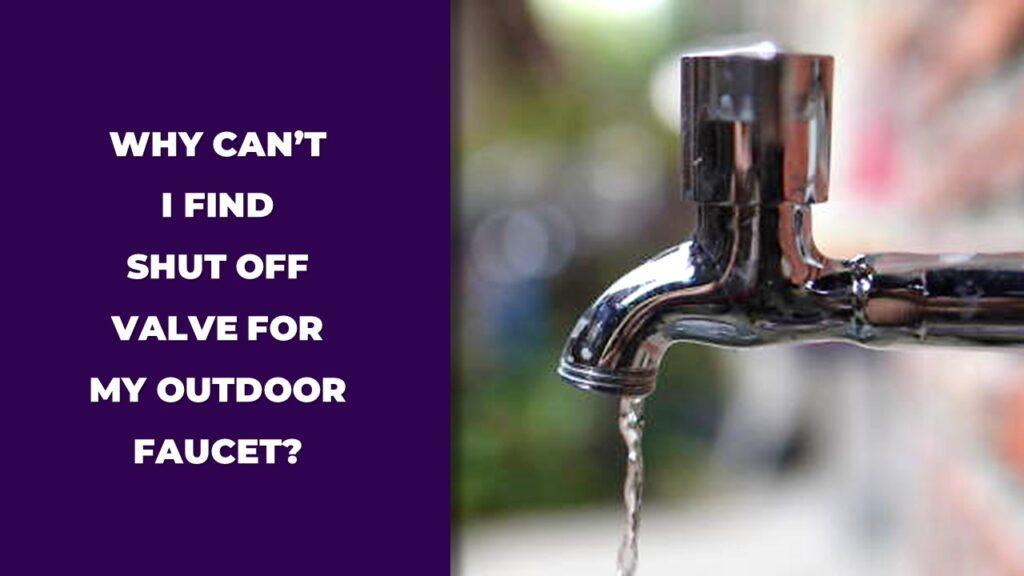
You can’t find the shut-off valve for your outdoor faucet because it’s often hidden, hard to reach, or sometimes not installed at all. In many homes, the valve is inside, maybe in the basement, crawlspace, or garage, right where the water line runs out to the faucet. Some houses don’t have a separate valve for the outdoor faucet, relying instead on the main water shut-off. If it’s not labeled, finding it can feel like searching for a needle in a haystack.
In this article, we are going to walk you through where to look for the shut-off valve, why it might not be easy to spot, and what to do if you don’t have one. We’ll cover common valve types, give tips for preventing outdoor faucet issues, and help you figure out your next steps if the valve is nowhere to be found.
Why Can’t I Find the Shut-Off Valve for My Outdoor Faucet? (Here It Is!)
You can’t find the shut-off valve for your outdoor faucet because it’s often not where you expect. It might be hidden behind a wall, stuck in the basement, or buried deep in a crawl space. In some homes, especially newer ones, there’s no separate shut-off at all—just a frost-proof faucet designed to handle cold weather. In older homes, the valve might be anywhere the builder had space to fit it, and chances are, nobody labeled it “hose bib” or “outdoor faucet” to make your life easier.
If you’re standing there with no clue where to look, you’re not alone. So many homeowners face the same confusion. The good news? There’s a process you can follow, and I’ll walk you through it step by step.
How to Find the Shut-Off Valve for an Outdoor Faucet (Step-by-Step)
Here are the step-by-step process to find the shut-off valve for an outdoor faucet:
- Check near the outdoor faucet, look on the wall, or the pipe nearby.
- Go inside the house, start with the basement, crawlspace, or garage.
- Follow the water line back from the faucet into the house.
- Look for valves along the line, possibly labeled “hose bib” or “spigot.”
- If it’s nowhere to be found, it’s possible there’s no separate shut-off valve.
Now, let’s take a closer look at each step and make it feel less like a scavenger hunt.
Step 1: Start Outside Near the Faucet
First, take a good look right by the faucet. You’d be surprised how many people overlook this step, thinking it has to be inside. Sometimes, the shut-off valve is right there on the wall, close to the faucet, or on the pipe coming up from the ground. Look for a small handle or lever—it might be a ball valve that turns a quarter-turn or a round knob you twist.
Also, check the ground near the curb or sidewalk. Some homes have a utility box there, and if you open it up, you might find a shut-off valve along with the water meter or irrigation controls. It’s worth a look.
If you have an irrigation system, that’s another clue. Your outdoor faucet could be tied into it, so the valve might be in the same spot where you control the sprinklers.
Step 2: Search Inside the House
Didn’t find anything outside? No worries, now we move inside. Head to the basement if you have one, and focus on the wall that lines up with your outdoor faucet. That’s where the water line usually comes through. Follow the pipe along the wall, and you might spot a small valve—sometimes labeled “hose bib,” “spigot,” or maybe not labeled at all.
If you don’t have a basement, check the crawlspace or the garage. Look near the water heater or the main water line where it comes into the house. Builders often installed shut-offs in those areas to keep them out of the way.
And if your basement is finished, don’t give up. Check for access panels in the ceiling or small cutouts in the drywall. Sometimes they hide valves behind those little doors, and it’s easy to miss. It can feel like a game of hide and seek, but you’re getting closer.
Step 3: Follow the Water Line
If the shut-off valve is still playing hard to get, your best bet is to follow the water line from the outdoor faucet back into the house. It might take a bit of patience and maybe even a flashlight, but it’s the surest way to figure out where the water goes and if there’s a valve along the way.
Look for any valves you come across. They could have a red or yellow handle, or a round knob. Some might be labeled, but many aren’t.
And here’s the thing, sometimes there just isn’t a shut-off valve for the outdoor faucet. If your faucet is frost-proof, the builder might have skipped installing one. It’s frustrating, but not the end of the world. If that’s the case, you can still protect the faucet by using an insulated cover in winter or talk to a plumber about adding a shut-off valve if you want extra peace of mind.
What If You Don’t Have a Shut-Off Valve for Your Outdoor Faucet?
If you can’t find a shut-off valve for your outdoor faucet, trust me, you’re not the only one. It can feel like you’re on a wild goose chase, pulling up ceiling tiles, peeking behind walls, or crawling around the basement, wondering if you’re missing something obvious. And then the realization hits—you might not have one at all.
Some homes, especially newer builds, don’t come with a separate shut-off for the outdoor faucet. Instead, they rely on frost-proof spigots that are supposed to handle cold weather. Older homes aren’t much better—sometimes the builder just didn’t add a valve, or it’s buried somewhere nobody thought to look.
So what do you do if you’re in this spot? Here are some real-world fixes:
- Grab an insulated faucet cover and slap it on before winter rolls in. It won’t work miracles, but it’s a simple way to help protect against freezing.
- Drain the faucet by opening it up and letting the water run out. This is especially important if you don’t have a shut-off valve.
- Know where your main water shut-off is. If you get into a jam, like a burst pipe, you can still stop the water to the whole house.
- Talk to a plumber. They can tell you if it’s worth adding a shut-off valve. It’s not always a huge job, and it can save you a ton of stress later.
- Keep an eye on the faucet after winter. Even if it survives the cold, check for leaks, rust, or drips that could turn into bigger problems down the line.
If you don’t have a shut-off valve, don’t feel like you’ve failed. There are workarounds, and you’re not alone in dealing with this.
What a Shut-Off Valve Consists Of
A shut-off valve might not look like much, but it can save you from a lot of headaches. It’s a small valve on the water line that controls whether water flows to your outdoor faucet. When you turn it off, you’re cutting off the water supply so no water reaches the faucet. That’s how you protect the faucet from freezing or leaking when the weather turns cold.
Here’s how you can tell what kind of shut-off valve you’re looking at:
- Ball valve: This one has a lever handle that turns a quarter-turn. When the handle lines up with the pipe, it’s open. Turn it so it’s across the pipe, and it’s off.
- Globe valve: Looks like a round faucet handle. You turn it to the right to close it, left to open it—just like a garden hose.
- What it’s made of: You’ll usually see brass or copper in older homes, but some newer setups use PVC or CPVC plastic.
- Labeling: Sometimes you’ll get lucky, and it’ll say “hose bib,” “spigot,” or “faucet.” But honestly, a lot of times there’s no label at all, which makes finding the right valve a guessing game.
Once you know what you’re looking for, spotting the shut-off gets easier.
Can You Add a Shut-Off Valve for an Outdoor Faucet?
Yes, you can absolutely add a shut-off valve, and for a lot of homeowners, it’s worth the effort. If your house didn’t come with one, a plumber can usually install it without much hassle.
Adding a shut-off valve gives you control. If winter’s coming, you can cut off water to the faucet and not worry about frozen pipes. If there’s a leak outside, you can stop it without having to shut off water to the whole house.
The process isn’t too complicated for a plumber. They’ll cut into the water line that feeds your faucet and add the valve somewhere you can get to, like in the basement, crawlspace, or garage. Then, when you need to shut off the faucet, it’s just a quick turn of the valve, and you’re done.
If you’re unsure whether you need a shut-off, talk to a plumber. They’ll take a look at your setup, explain your options in plain language, and help you figure out if adding a valve is the right move for your home.
Tips for Preventing Outdoor Faucet Problems
Here are some simple tips to keep your outdoor faucet safe:
- If you have a shut-off valve, close it before freezing weather hits.
- Drain the faucet after you close the valve by opening it up and letting water run out.
- Use an insulated faucet cover in winter, even if you have a frost-proof faucet—extra protection never hurts.
- Check your faucet in the spring for any signs of damage, leaks, or rust.
- Fix any small issues quickly before they turn into bigger, more expensive repairs.
A little attention goes a long way. Your faucet doesn’t need much, but it needs something, especially when the seasons change, to keep your faucet in top condition.
Quick Reference Table: Common Valve Locations and Actions
If you’re still hunting for the shut-off valve, here’s a quick breakdown of where to look and what to do when you find it. This table is like your cheat sheet when you’re feeling stuck, cold, and tired of searching.
| Location | Checkpoints | Actions |
| Outside near the faucet | Wall pipes, ground boxes, and utility boxes | Open or close the valve if found |
| Basement | Near the main line, exterior walls, and ceilings | Trace water lines, check for access panels |
| Crawlspace | Along water lines | Look for valves along the pipe |
| Garage | Near the water heater or main lines | Inspect walls for hidden valves |
| No valve found | Frost-proof faucet or no shut-off installed | Consider adding a shut-off or insulating the faucet |
Sometimes it feels like a treasure hunt, but keep going. If you don’t find it, you still have options to protect your faucet.
Conclusion
If you’re wondering why you can’t find the shut-off valve for your outdoor faucet, you’re not alone. Many homes either don’t have a separate shut-off, or it’s hidden in hard-to-reach places like a basement or crawlspace. Some rely on frost-proof faucets, which work without a shut-off, but that doesn’t mean you’re out of options.
To find the shut-off valve for your outdoor faucet, check near the faucet, follow the water line into your house, and look in common spots like the basement or garage. If there’s no shut-off valve for your outdoor faucet, consider using an insulated cover or draining the faucet before winter.
Whether you find a valve or not, knowing how to protect your outdoor faucet can save you time, money, and a big mess when cold weather hits. If in doubt, a plumber can help you figure out the best solution for your home.
Related FAQs
Why don’t all homes have shut-off valves for outdoor faucets?
Not every home has one because some builders install frost-proof faucets instead, while others just skip it altogether. It’s common in newer homes, but older homes can be hit or miss.
How do I know if I have a frost-proof outdoor faucet?
Check for a long, horizontal pipe behind the faucet inside the house. If the faucet’s handle is at an angle or the spout is slightly slanted, that’s usually a frost-proof design.
Can I use my main shut-off to stop water to the outdoor faucet?
Yes, in an emergency, the main shut-off will stop water to the whole house, including the outdoor faucet. It’s a good backup if you don’t have a separate shut-off.
How much does it cost to install a shut-off valve for an outdoor faucet?
Adding a shut-off valve can cost anywhere from $150 to $350, depending on your plumbing setup and the plumber’s rates. It’s a small investment for peace of mind.
What happens if I leave water on in winter without a shut-off valve?
If water stays in the pipe during freezing weather, it can freeze, expand, and burst the pipe or faucet. That leads to leaks, water damage, and a mess you don’t want to deal with.

Dylan Foster is a family man with years of hands-on experience in plumbing, household maintenance, and fixing everyday issues around the home. A former plumber, Dylan knows what it’s like to deal with tricky leaks, worn-out parts, and all the little problems that pop up in a house. From plumbing repairs to kitchen fixes and garden hose setups, he’s done it all. Dylan shares real-world solutions to help others keep their homes running smoothly and avoid costly mistakes.




